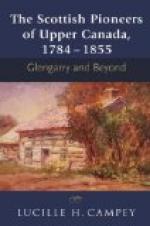It will be men with English and Scottish names, mainly, who will henceforth complete the work begun and established so magnificently by Cartier, Brule, Nicollet, Jolliet, La Salle, du L’Hut, and La Verendrye, though the French Canadians will also play a notable part, together with “Americans”, from New England.
CHAPTER VI
The Geographical Conditions of the Canadian Dominion
Before we continue to follow the adventures of the pioneers of British North America, I think—even if it seems wearisome and discursive—my readers would better understand this story if I placed before them a general description of what is now the Dominion of Canada, more particularly as it was seen and discovered by the earliest European explorers.
The most prominent feature on the east, and that which was nearest to Europe, was the large island of NEWFOUNDLAND, 42,000 square miles in extent, that is to say, nearly as large as England without Wales. It seems to bar the way of the direct sea access by the Gulf of St. Lawrence to the very heart of North America; and, until the Straits of Belle Isle and of Cabot were discovered, did certainly arrest the voyages of the earliest pioneers. Newfoundland, as you can see on the map, has been cut into and carved by the forces of nature until it has a most fantastic outline. Long peninsulas of hills alternate with deep, narrow gulfs, and about the south-east and east coasts there are innumerable islets, most of which in the days of the early discoverers were the haunt of millions of sea birds who resorted there for breeding purposes. The heart of Newfoundland, so to speak, is an elevated country with hills and mountains rising to a little over 2000 feet. A great deal of the country is, or was, dense forests, chiefly consisting of fir trees. As numerous almost as the sea birds were the seals and walruses which frequented the Newfoundland coasts. Inland there were very large numbers of reindeer, generally styled nowadays by the French-Canadian name of Caribou[1]. Besides reindeer there were wolves, apparently of a smaller size than those of the mainland. There were also lynxes and foxes, besides polar bears, martens, squirrels, &c. The human inhabitants of Newfoundland, whom I shall describe in the next chapter, were known subsequently by the name of Beothuk, or Beothik, a nickname of no particular meaning. They had evidently been separated for many centuries from contact with the Amerindians of the mainland, though they may have been visited occasionally on the north by the Eskimo. They had in fact been so long separated from the other Amerindians of North America that they were strikingly different from them in their habits, customs, and language.




